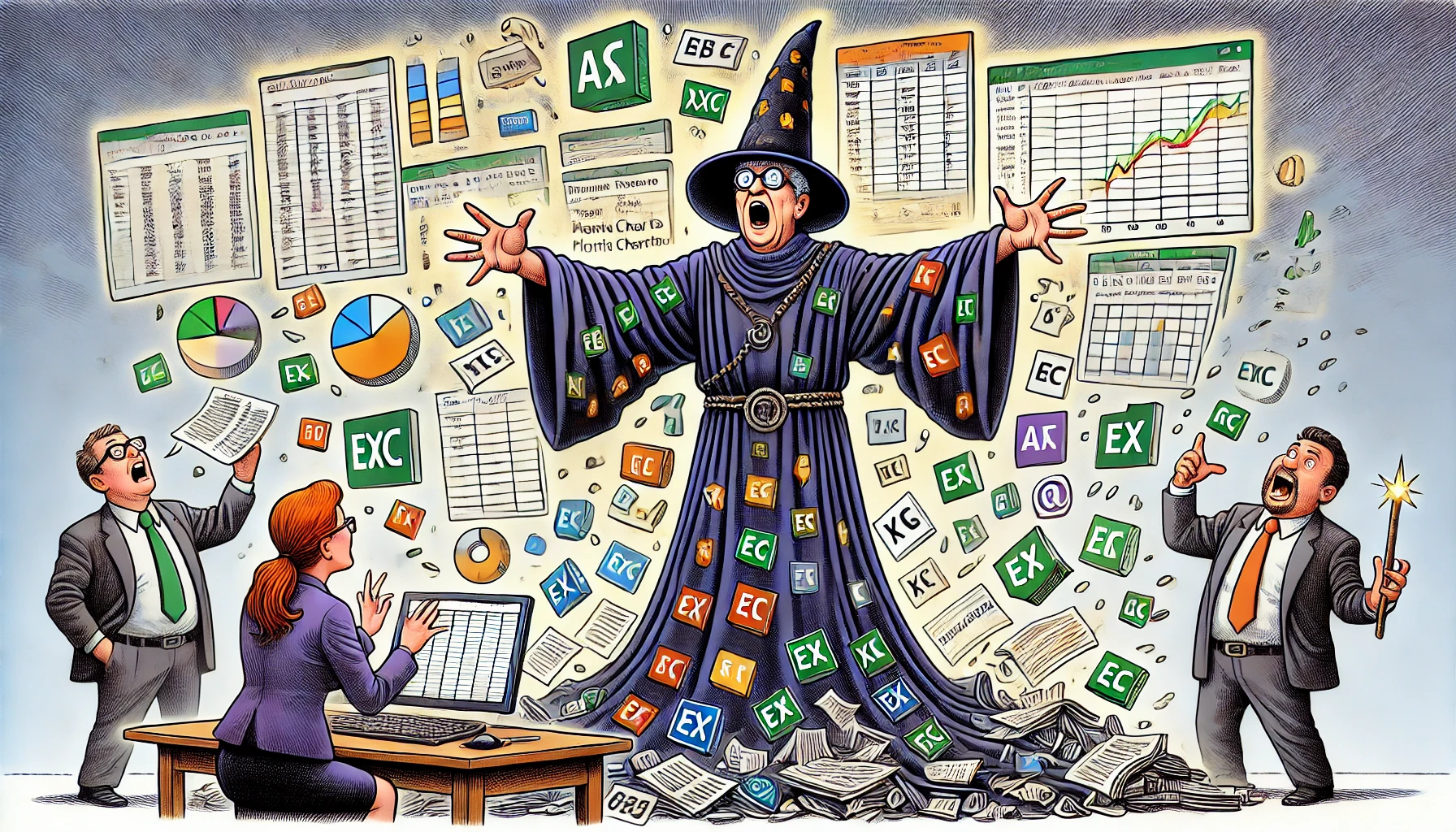1. Definition:
Introducing The Spreadsheet Sorcerer — once a lowly data analyst, now a self-appointed corporate oracle of Excel magic. This is the office dickhead who believes their labyrinthine Excel models hold the secrets of the universe. Armed with a vocabulary of acronyms (they’ll casually drop terms like NPV, IRR, and “Monte Carlo simulation” as if reciting ancient spells), the Sorcerer is convinced every spreadsheet they conjure can predict the future.
In reality, they understand nothing about what they’re actually modeling; they just layer on more tabs and formulas, hoping that complexity will somehow birth wisdom. They exist purely to build overly complex models, demand absurd amounts of irrelevant data, and bask in the glow of their multi-colored pivot tables — all in a quixotic quest for “ultimate forecasting precision.” Truly, this Excel-obsessed financial mystic worships at the altar of complex formulas and flawed assumptions, believing wholeheartedly that if a number exists, it must be divine prophecy in cell A1.
2. Parody Scenario:
- Morning: At 7:00 AM sharp, the Spreadsheet Sorcerer fires off a company-wide email demanding hyper-specific, absurd data points from every department. Marketing must deliver last quarter’s customer churn rate broken down by zodiac sign; HR needs to provide the CEO’s daily caffeine intake measured in milligrams; IT is asked for server uptime and the average number of times the intern blinked during Q2. Each number, the Sorcerer insists, will help “tune the mystical forecasting crystal ball” of their Excel model. Colleagues reading this email wonder if they’re still dreaming — or if someone spiked the Sorcerer’s coffee with formula juice.
- Mid-Morning: By 10:00 AM, armed with an avalanche of data (most of which no sane person would ever use), the Sorcerer retreats into their lair (a.k.a. the windowless conference room) to craft a behemoth 200-tab spreadsheet. For six straight hours, they toil like a mad scientist: cells stuffed with nested IF statements that go 12 levels deep, pivot tables summoning summaries of summaries, and a Monte Carlo simulation running a million random scenarios (just because it sounds fancy). The result? A hulking monstrosity of a workbook that causes lesser laptops to freeze in terror. None of these convoluted calculations actually improve the forecast’s accuracy one bit — but boy, do they make it look impressively incomprehensible.
- Lunch: At 12:30 PM, the Sorcerer derails everyone’s lunch break with an emergency meeting. The crisis? Someone dared to question an assumption in cell XFD1048576 of their model (the nerve!). A junior analyst innocently asks why the model assumes a 110% customer retention rate (which implies customers are reproducing or something). The Spreadsheet Sorcerer reacts as if asked to deny their faith: they gasp, clutch their mouse, and launch into a dramatic monologue about how a mere 0.01% change in customer acquisition costwill doom the company to bankruptcy and probably cause the sky to fall. Colleagues exchange eye-rolls and muffled snickers as the Sorcerer frantically scrolls through hundreds of tabs searching for the “offending” cell, treating this 0.01% difference like an existential threat to the very fabric of the universe.
- Afternoon: Around 3:00 PM, true disaster strikes — an intern accidentally deletes a single cell in the Sorcerer’s masterpiece spreadsheet. Panic ensues. The entire financial forecast promptly implodes like a neutron star, collapsing in on itself with
#REF!errors cascading across the screen. The Sorcerer responds like a parent who just discovered their child drew crayon scribbles all over the Mona Lisa. They shriek, “WHO TOUCHED MY MODEL?!” and dive under their desk to undo the damage. For the next hour, they attempt to resurrect the broken formula as if performing CPR on a spreadsheet, muttering arcane Excel functions under their breath like prayers (“=INDEX(…MATCH(…))… please work, please work…”). The office tiptoes around them, afraid that any sudden movement might further upset the delicate cosmos contained in that Excel file. - Evening: By 7:00 PM, after subjecting the company to a day of spreadsheet sorcery and drama, our hero is ready to unveil the grand prophecy. In a late-evening meeting (because of course this couldn’t wait till tomorrow), the Spreadsheet Sorcerer presents their “findings.” This consists of a completely manipulated chart, complete with absurd 3D pie slices and color-coded trendlines, that — surprise! — conveniently proves whatever their boss wanted to hear in the first place. The Sorcerer speaks in grave, self-important tones about “strategic insights” and “robust projections,” while everyone else struggles to stifle laughter and exhaustion. In the end, it’s clear that all the complexity was just smoke and mirrors; the conclusion was predetermined. The boss nods along and applauds the Sorcerer for their “hard work and brilliant analysis,” while the Sorcerer beams, utterly oblivious to the trail of bewilderment and wasted hours left in their wake.
3. Why They Exist:
The Spreadsheet Sorcerer exists because corporate culture often mistakes complexity for competence. Executives see a 500-line formula or a 200-sheet workbook and assume “Wow, this is genius!” rather than asking “Wait, does any of this actually make sense?” It’s a classic case of mathematical theater – dazzling the higher-ups with technical hoopla so no one questions the substance (or lack thereof). Common sense gets shown the door, because why trust gut instinct or simple logic when you can trust a jittery, overstuffed Excel model that takes 10 minutes to recalc?
Moreover, leadership needs someone to blame or bless when it comes to big decisions, and preferably a “data-driven” rationale to justify decisions they’ve already made. They crave those fancy charts and booming numbers to point at and say, “See? The model says so!” (even if the model is basically a glorified Etch A Sketch). Enter the Sorcerer: they’re more than happy to oblige, providing an avalanche of pseudo-analytical proof to rubber-stamp whatever the boss wanted to do anyway. In short, this Excel enchantment persists because it gives everyone plausible deniability — if things go wrong, they can blame the 10,000-cell prophecy that “predicted” it, instead of admitting perhaps we should have used common sense.
4. How to Spot One:
- Jargon Jester: They only speak Excelese. You’ll hear them drop words like “pivot table,” “VLOOKUP,” and “sensitivity analysis” in everyday conversation (yes, even while discussing what to have for lunch: “Let’s perform a sensitivity analysis on pizza toppings.”). If someone mentions weekend plans, they might chime in with, “I’ll run a quick Monte Carlo on that and get back to you.” Translation: they’ve officially lost the ability to communicate like a normal human.
- Data Hoarder: They request absurd amounts of data for even the tiniest decision. Ask them to forecast next month’s office stationery budget, and they’ll demand ten years of employee headcount, hourly printer usage stats, seasonal pen consumption trends, and the CEO’s shoe size for good measure. Of course, they won’t use 90% of this ridiculous data haul — but collecting it makes them feel like a genius. (Why make do with a simple estimate when you can swim in a data lake of utter irrelevance?)
- Monte Carlo Preacher: They talk about Monte Carlo simulations with the reverence of a sacred text. To hear them speak, you’d think “Monte Carlo” was an actual oracle living inside Excel, rather than a fancy way to say “I let the computer roll dice a thousand times.” They’ll solemnly intone, “According to our Monte Carlo results…” while ignoring the fact that they essentially just generated a ton of random numbers and averaged them. It’s statistical voodoo at its finest.
- Assumption Defender: They call emergency meetings whenever anyone questions their model’s assumptions. If you dare ask, “Um, why are we assuming customers will double every month?” be prepared for dramatic outrage. They’ll bluster about “industry-standard growth rates” and “proprietary forecasting algorithms” without ever directly answering if the idea itself is sane. Simple yes-or-no queries make them break into a sweat. Instead of admitting “Yeah, that assumption is bonkers,” they’ll defend it like it’s a PhD thesis, effectively responding, “How dare you question the sacred cells?!”
5. How to Deal With Them:
- The “Common Sense Shortcut” Trick: Politely ask the Sorcerer to explain their 500-tab model in one PowerPoint slide. As they attempt to distill their magnum opus, you’ll witness something truly magical: their soul visibly leaving their body. Nothing causes them more agony than having to simplify their baby. It’s like asking a cat to write a Shakespearean sonnet. Enjoy the sputtering and stammering as they realize they cannotsummarize the nonsense — thereby exposing that maybe, just maybe, all those details weren’t so necessary after all.
- The “Does Your Model Predict Reality?” Move: Casually inquire whether any of their previous grand Excel models ever actually predicted real-world outcomes. (Bonus points if you drop this question in front of their boss.) The Sorcerer will freeze like a glitching spreadsheet. Expect a litany of excuses: “Well, there were unforeseen variables…” or “Market conditions changed unexpectedly…” — which are just fancy ways of saying “Nope, never got it right.” This simple question is like shining sunlight on a vampire; watch them recoil as their predictive prowess is revealed to be about as reliable as a coin toss.
- The “Data Detox” Challenge: Feed their data addiction with a twist. Slip in a few deliberately ridiculous data points and see if they take the bait. Suggest that the average zodiac sign of our top 50 customers or the number of office plants on each floor might be crucial variables, and hand those stats over. The Sorcerer, delighted by more data, will likely plug even these into their next model without blinking. When their spreadsheet later declares “Q4 sales will spike if most customers are Geminis and we buy two more ficus plants,”you can sit back and cackle. You’ve successfully proved they’ll incorporate literally anything into their “analysis.”
In the end, surviving The Spreadsheet Sorcerer is all about keeping perspective (and your sense of humor). Remember, beneath the pivot tables and perplexing formulas lies a fellow human who took “Excel is life” way, way too literally. With a few clever moves and a well-timed eye-roll, you can cut through the crap, inject some common sense into the equation, and maybe even coax this Excel-obsessed mystic to step away from the keyboard and join the rest of us in reality — at least until the next forecast is due.



